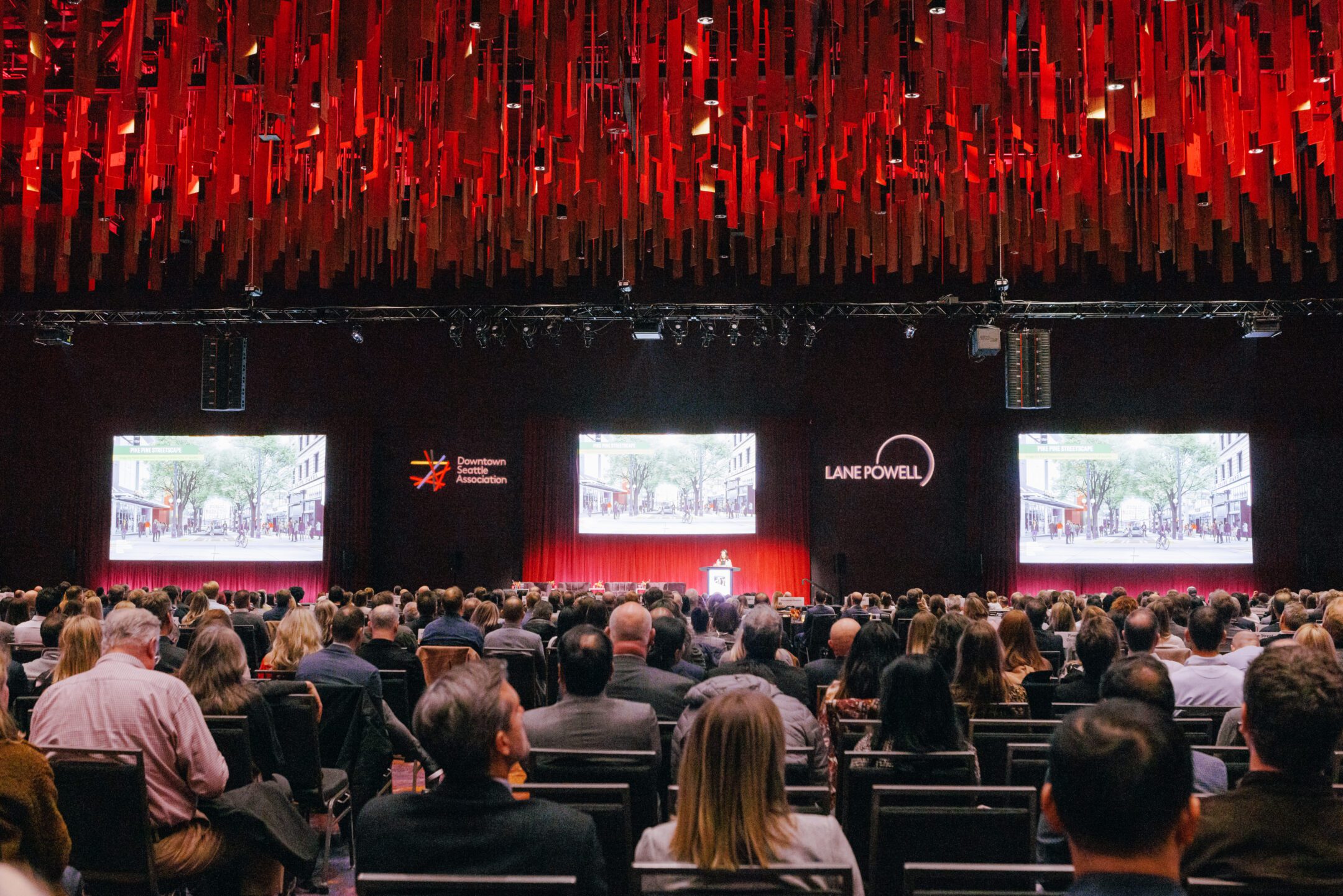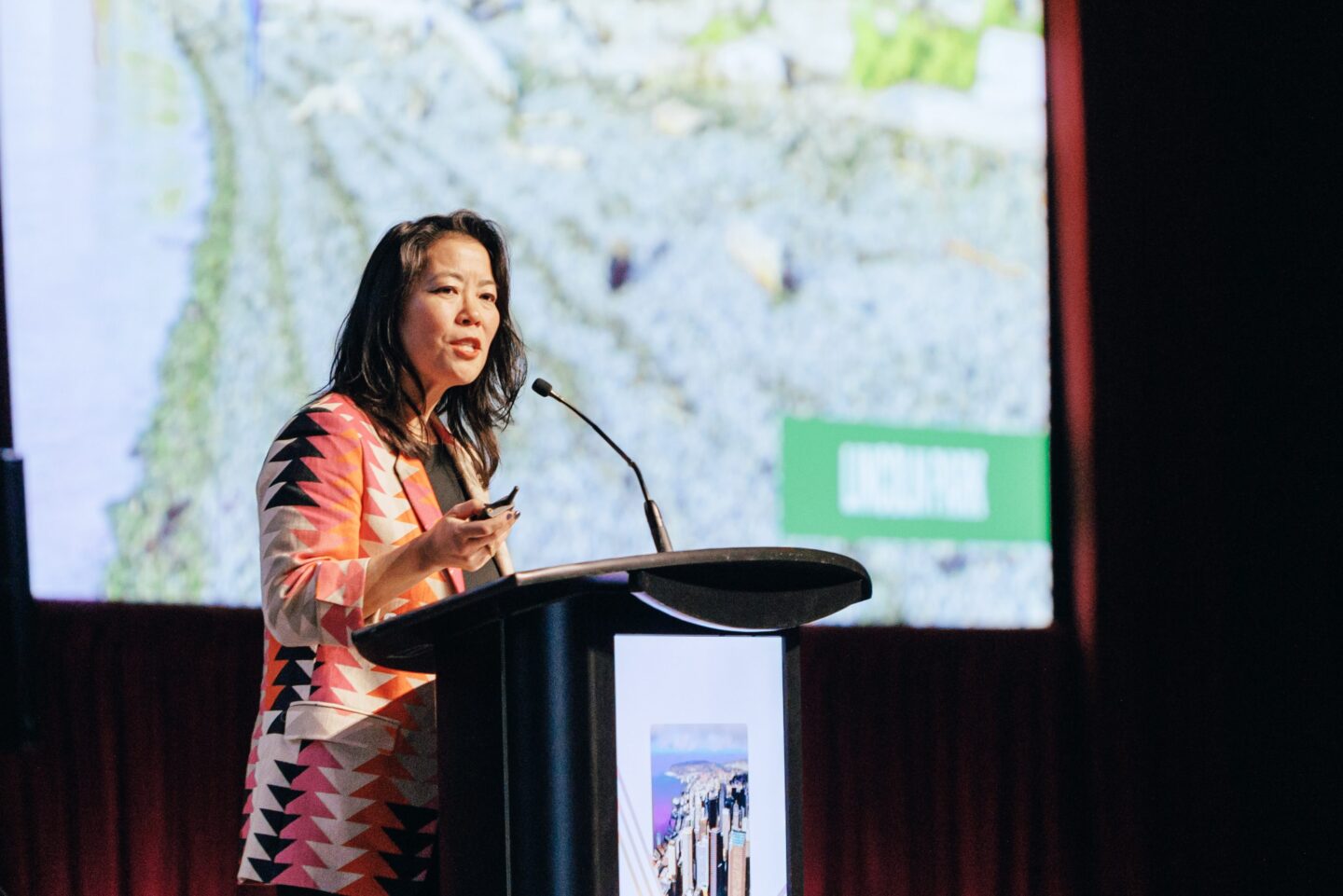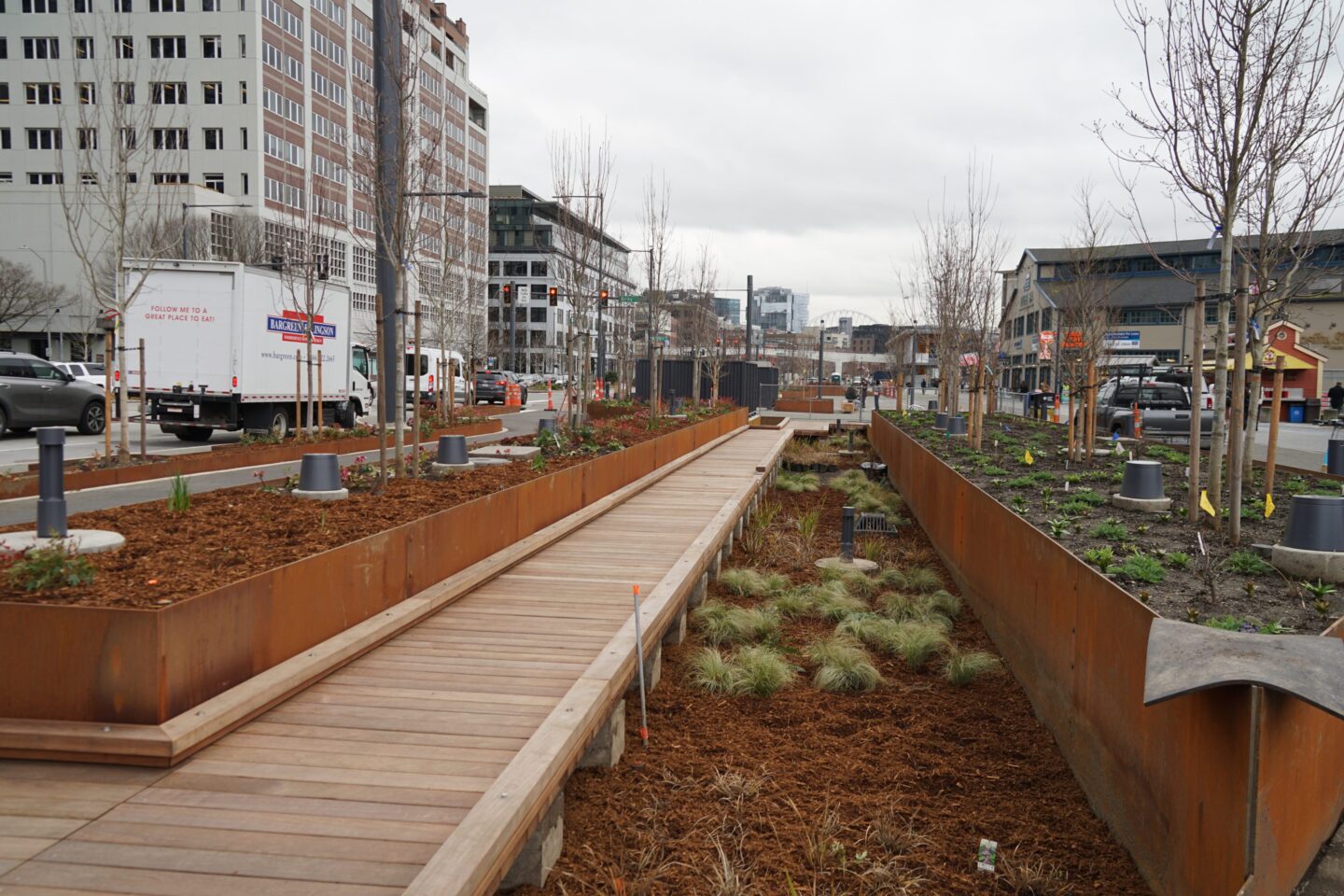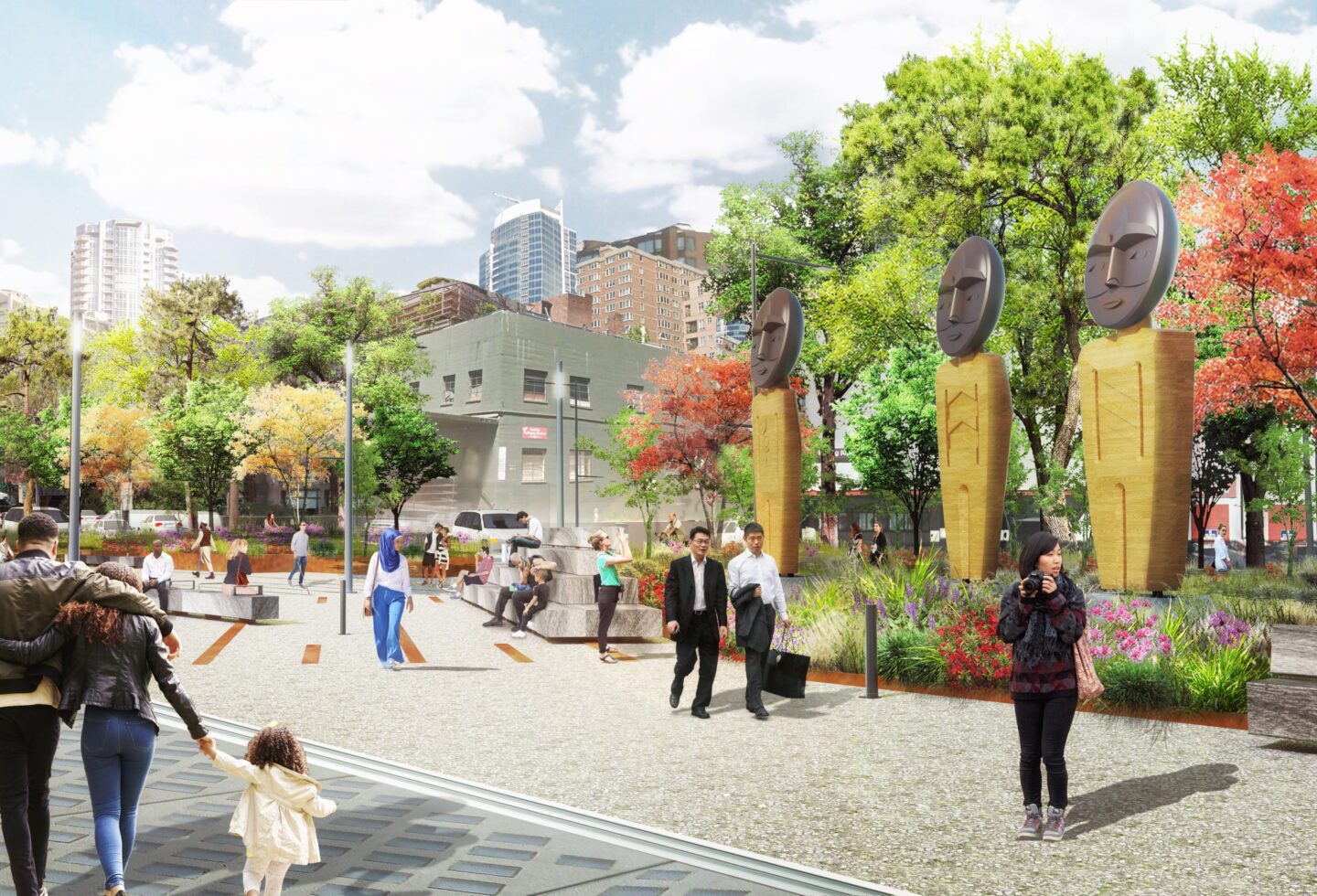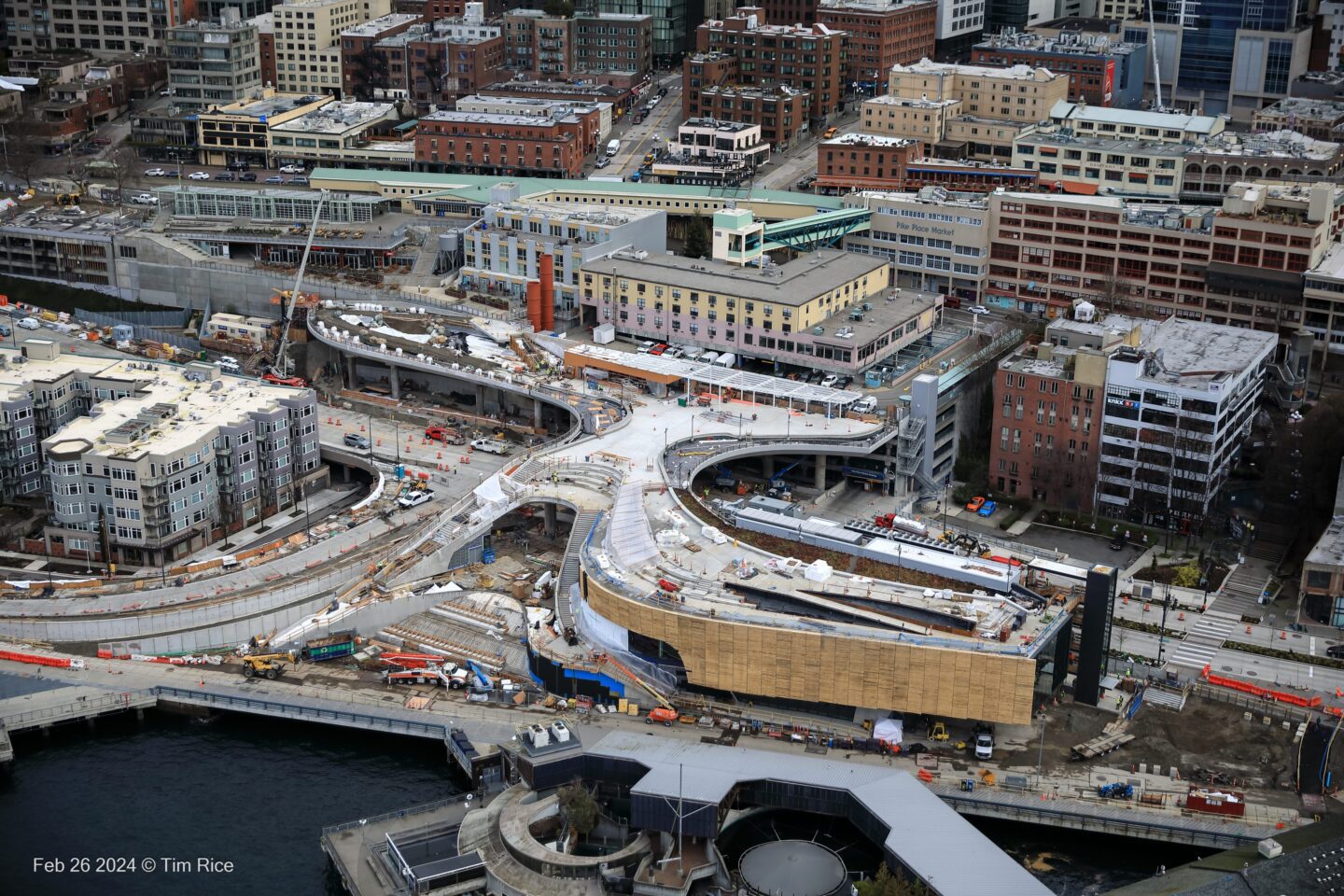Transforming Seattle’s Waterfront
A presentation by Friends CEO & President, Joy Shigaki, from the 19th Annual State of Downtown in March 2024.
Watch Now
On March 7, 2024, Friends of Waterfront Park’s CEO & President, Joy Shigaki, delivered a keynote presentation on future Waterfront Park, the work of Friends, and the extraordinary effort to deliver on this world class project. She spoke to more than 1,100 business and civic leaders at the Downtown Seattle Association’s State of Downtown. Watch the video or read the transcript at the link below to learn more about the about this transformative civic space opening in early 2025.
Video Transcript
Good afternoon. I’d like to thank Jon, the DSA board, and staff for this invitation to be with you today.
I’d like to also acknowledge our elected officials DSA members and sponsors, many of our colleagues with the City of Seattle, Friends board and staff who are here, community organizations, civic leaders, residents, and downtown champions and advocates. Thank you for your belief and investment in the city. The theme of Community and Connection couldn’t be more appropriate for Waterfront Park. What you saw in that segue video was pretty powerful. Starting with the beginning of this place which is Coast Salish land, and those who are still thriving in this place, but also the audacity of a city like Seattle, and what it’s taken for us to grow into ourselves and also be resilient through also what was a difficult time of pandemic.
Waterfront Park is a project that is more than 15 years in the making and I think that that’s a reminder of how big audacious projects can happen with the talent of people in a city like Seattle. We’re known for our innovation, our passion, our creativity, and our audacity, and this is one of the largest campaigns for a civic space in our city, and I think we should be very proud of that. It’ll be a catalyst for reimagination, for revitalization of downtown, and the 15 million people who are anticipated to come to enjoy the beauty of our Waterfront, but also discover the rest of downtown and our neighborhoods. The Elliott Bay Connections project will continue this experience for an additional 16 acres and Leslie’s going to talk a little bit about that. But Waterfront Park is opening in a year and I came back only a year and a half ago, so many of you were dealing with the construction for 10, 12 years, but it’s absolutely thrilling that it’s in our sight line and it’s a year from opening.
So I’m a kid that grew up in Seattle. I grew up in parks which have a lot of special meaning and memory for me. I ran the trails at Discovery Park, got my first Nettles. I climbed this like very unfriendly child structure if you were there in the 70s and 80s, and ate my mom’s rice balls and chicken as we played a mean game of whiffle ball. I had family events, birthday parties, community events at Seward Park and walked that loop, time and time again, both with friends, but also needing time just to reconnect and find respite being in nature.
I was a kid at Rainier Playfield. We ran around in summer nights as my dad played softball and we saw ourselves in that community, being able to play safely and seeing kids that look like us, and later as a Franklin High School tennis player. Go Quakers! Any Quakers in the house? Alright, thank you. Worked on my serve, but also found a sense of place and safety in the South End as a public high school kid. And so when you think about your favorite Park in the city, or the place that you grew up in, what do you smell and taste and hear? And who are you with? Is it someone that you love? Are you there for a special family memory or event, or a cultural event? And are you finding respite in nature, just to disconnect, because even as humans, we really need to be in nature. And are you feeling a sense of belonging a sense of joy? A sense of connection to place? And how is it a reflection of that city, whether it be Seattle or the place that you live.
This is Pier 62 at Waterfront Park that opened in the throes of COVID, in the fall of 2020. No ribbon cuttings, no fanfare, lots of masks. But we have been programming this park, thanks to the work of the City of Seattle who has built this extraordinary place, to be able to bring community together. to connect to create belonging, and to create memories.
This was last year’s REI S’mores on the Shore, and we expected 200 people, and we had 900 people on the wettest day. This Sunday we’re actually having our final fire pit and REI is also hosting so please come down. Last year we hosted our Lunar New Year event. There’s a trend. We thought maybe 400 people would come, but it was the day after the massacre in Southern California, and over 2500 people came to be in community, to be connected, even when times are difficult, and to find a sense of place in this incredible space. And this is Soul on the Water, sponsored by Africatown, really bringing the best of the Black community’s culture, art, and community, and connection back to the Central District.
Over a million people have come to Pier 62 and it has been a reminder of how parks can be transformative. That they’re made for, and they make for, dynamic, democratic cities. And nationally we’re seeing this trend of reclaiming old infrastructure projects–highways, double-decker highways, railroads–to be able to reclaim the beauty of our cities from what they once were. And Waterfront Park is going to be part of that renewal. It is going to be part of the revitalization and part of creating a place that everyone sees themselves in, and memories to be created.
Alright, so the reminder, this is a place that’s on Coast Salish land. The stories, the voices, the histories are centered in this place of Indigenous people, and will continue to be centered in the work of Friends, and how we keep evolving this place for our city and our region. So a reminder like the segue video, this extraordinary double-decker highway cut across the most beautiful part of our city, like the Embarcadero in San Francisco, like other cities across the nation. It was not about human-centered design, it was about disconnection. But the audacity of the vision, after the 2001 Nisqually earthquake, but conversations even before that was, “What happens when they build a new tunnel…” We actually had a final walk and party on the viaduct. I heard there were like 100,000 people for that. “…and tear it down to reveal what is possible about a new Waterfront, and a new park to be born.”
It is a 20-acre park that is in the shadow of the former Viaduct. I’ve met people who actually moved after the viaduct came down and have said, “What’s the big deal?” It’s like, “Oh, you don’t remember.” So part of the storytelling of this place is retelling that story, right? What it took to get here, to take that double-decker highway down. The political leadership, residents, advocates. This 20-acre park, running from the Stadium District, all the way to Belltown, will be creating this dynamic tapestry of experience of public space, connection to the Waterfront. The tendrils back down to Pioneer Square, the 20-block Pike/Pine Extension to Capitol Hill, and down back to the Pike Place Market, is part of that vision of reclaiming this extraordinary space.
There is massive economic impact on this project as well and so that is an important aspect of this. The Office of the Waterfront and Civic Projects, our colleagues who are here. Angie Brady, who’s the current director, and her team are building this extraordinary park with the talent of contractors and amazing construction workers. Over $ 1.1 billion dollar in construction overall, 6,200 jobs, and then there’s a reality of ongoing economic impact. To bring locals, regional visitors, national and international visitors for spend. Of experiences, of hotels. And then the quality of life for the 100,000 people who live downtown. For the people who are in these areas, and many low income communities who are also around in this area, and to create a vibrant downtown that we know it.
So a little bit about Friends of Waterfront Park. We are a nonprofit that was established in 2013. So when you think about these big urban infrastructure projects and big parks, the new model nationally is needing the leadership of a nonprofit to provide fundraising, organizational management for programming and activation, stewardship, and park operations. And in our case, with our partners with Seattle Center which I’m going to talk a little bit about. And it’s not just as of now, it’s for generations to come, so we care for this place in extraordinary ways. So you think about groups like Friends of the Highline in New York, or Friends of the Underline in Miami. We are becoming that trusted nonprofit to be working in partnership. And that work is done through partnership, fundamentally, through public-private partnership. And it’s leveraging the best strengths and assets, as Jon talked about, with people across our cities: nonprofits, businesses, residents, community-based organizations. That’s the core of our work and that’s the invitation to all of you.
Our first decade of Friends is really modeled. Our transformative placemaking, the innovation and piloting centered in equity. Because you can build the the place and expect them to come–and that was a movie–but that model is flawed, because you have to be intentional to ask why people do not feel that sense of safety and inclusion and belonging in public space. And so friends has been driving programming and operations and community engagement from the early design back in 2012, and bringing over 400 community groups together, and meetings together, to be able to share information and test this programming. We’ve been doing public safety, the campaign for Waterfront Park. We’ve been a convenor and really centering in DEIA, and what it means to build equity. And what that means is that we listen. You really ask the question of who is not included and how do we go deeper to make people people feel that sense of connection by co-designing programs, by co-curating programs. Our team is doing incredible work alongside extraordinary community organizations in Seattle, and keeping that experience local. We do that also through our community committees, advising us, helping us make sure that we’re staying true and accountable to the work, because this is going to make it a park for all. And this is just a sampling of our program impact. The last three years, 176,000 people have come for our free public programs, over a million people have come to Pier 62, and on, and on. Our cultural masterplan will be launching in the next couple months, asking the question of “How does this become this extraordinary new civic space for our city?”. We’ve been doing programming with community–skating like a girl and hosting Salmon Homecoming–which is true to who we are.
And this moment too is actually really exceptional. This is not only a moment of transition for the viaduct, but for Friends, and we have moved forward with an exclusive sneak peek into our rebrand, which is a reminder of the iconic piers that we are sitting on, and the park that we’re creating together. Hopefully it’s fresh and it’s welcoming, and we will become your favorite neighbor and organization that you’re going to want to be part of, so more to come.
But a little bit of the progress on the waterfront, and I’ll do my best to honor our colleagues with the Office of the Waterfront and Civic Projects and the contractors who are working on this. This is Railroad Way on the southern end of the park, that’s butted up against the Stadium District, and how it’s looking now on Railroad Way: an open area for gathering, for moving folks who are visiting and going to games at the Stadium District, or going to concerts, and make their way back to the Waterfront. The Pioneer Square Enhancements that will create this extraordinary pedestrian-friendly experience connecting from the Waterfront into Pioneer Square and a recent groundbreaking. Pioneer Square Habitat Beach, that had a soft opening in time for All-Star Game. And opened to the public for people to be able to touch the water for many, many years. It’s been many years, and be able to enjoy the views of the Salish Sea and a quiet moment alone.
Our 1-mile Park Promenade that runs from Pioneer Square, all the way north to Pier 62, that will create this extraordinary connection along Waterfront Park–and actually, on the right hand side, they’re actually swings that have just been installed–to give everyone an experience to connect to the beauty of this place, but also to make safe passage all along the promenade. Benches have gone in and thousands of plants, trees, and other bushes are also going in to make this a lush beautiful Park. Pier 58, formerly Waterfront Park, is currently under construction and will open by the end of ’24, early ’25. We’ll have a beautiful lawn and tree grove, places to gather and activate. The Pike Pine Streetscape, which will open this fall, makes for great safe passage all along Pike and Pine for 20 blocks, from Pike Place Market all the way to Capitol Hill and down to the Waterfront.
And Ocean Pavilion. Our colleagues, Bob Davidson and his team, are preparing to open the extraordinary Ocean Pavilion which is embedded in Waterfront Park and the Overlook Walk, and it’ll be a world class aquarium reflecting on conservation internationally and generating new generations of conservation leaders. And the Overlook walk the real sweet spot–I kind of sell it as the selfie spot. It’s going to give you the experience of a 360-degree views, the same height of the Viaduct, for those of you who are really missing those views driving north on the viaduct, people talk about that a lot. And extra, new places to sit and to reflect, and the beauty of the landscaping–you see the boulders that have recently gone in. The Salish Steps and the views that you’ll be able to take in.
We are wrapping up the Campaign for Waterfront Park which is $170 million effort and we’ve raised 88% of that goal, which is extraordinary, and we’re in the last stretch to get there so it’s a real invitation to all of you to join us, to close this chapter of this campaign and move into how Waterfront Park is going to be part of this town and this ecosystem.
We’re making public safety investments. We’ve invested $3 million to date on Pier 62 alone, modeling a new model for public safety that’s centered in a humane approach, as Jon talked about. We’re working with project REACH to provide outreach workers for those who are unhoused. Our staff are the eyes and ears on the park, and a new partnership with Seattle Center is providing public safety officers to be able to be available to address issues, to be able to enforce park rules, and then you call the Seattle Police Department when it’s needed, but that unique approach is what we need to solve for some of these more challenging issues. As part of that partnership, we invested $5 million that was matched by the Metropolitan Park District because public-private partnership is critical for solving for challenging issues, and that’s important for making sure that this park is a park you all feel safe when you come, and everyone feels that sense of welcome.
Our partnership with Seattle Center, I’d like to call out our colleagues that are here, started on July 1st and we are grateful for the wisdom and the expertise that exists on that 78-acre campus. They are providing extraordinary urban park space management with Friends and we’re absolutely thrilled that they will be managing maintenance and public safety, now into the future.
I just want to say for a moment to recognize there are many, many people in this room. I came back, many of you know only about a year and a half ago, and I recognize that the audacity of projects like this take many, many people. And there are a lot of civic leaders in this room who have fought and solved, and fought and solved, and tried to figure things out from the very beginning, but that’s what it takes for these kind of projects. And I just want to take a minute to really just acknowledge many, many people between the Friends board and staff, many civic leaders in this room, businesses, residents, LID rate payers that have gotten us here. The city mayors—there have been many in this project, I think there seven—city council members, city staff contractors and designers, our governor, WSDOT and the Port of Seattle, the Office of the Waterfront and Civic Projects, Angie Brady, who’s the current director, and Marshall Foster, the former director who’s now at Seattle Center. They just need a lot of credit for that exactly. The Seattle Parks Department, Seattle Department of Transportation, and then a special shout out to the Seattle Historic Waterfront Association, the Pike Place Market PDA, the Alliance for Pioneer Square, and the DSA for supporting the LID. Thank you.
We do audacious things in Seattle. We are going to make memories at Waterfront Park, and the grand opening will be happening in less than a year, in early ‘25, so stay tuned. It’ll be followed by seasons of activation and programming that’ll be led by Friends and our community. So come to S’mores on the Shore—call to action, if you’re around this Sunday. Take a walk on the waterfront and see how much is changing, and see this park taking shape. Reach out to us about grand opening sponsorship, about co-promotional opportunities, and give to the Campaign for Waterfront Park. And we just want to invite you to be friends and remember, this city is extraordinary and we appreciate all that you do in this room. Thank you.
